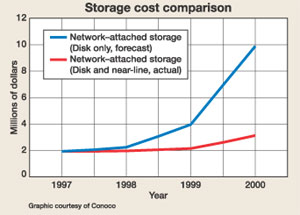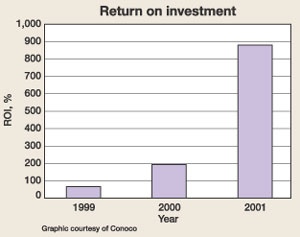Large data volumes can be handled cost-effectively
EXPLORATION & EXPLOITATIONLarge data volumes can be handled cost-effectivelyA digital asset management solution to the handling of large data volumes was developed over the last several years by an alliance of service companies. An initial installation of the system at Conoco’s GOM Deepwater Exploration Business Unit has proven its worth and given explorationists new capabilitiesJames M. Johnson, Product Development Manager, Ovation Data Services, Houston
A cost-effective solution to the storage, retrieval and management of very large data volumes has been developed over the past several years through an alliance of Large Storage Configurations (now part of SUN Microsystems), Ovation Data Services (ODS), SONY Electronics / Data Systems Division, and SUN Microsystems. This project was first discussed in an article published in the June 1999 issue of World Oil.1 Members of this group felt strongly that the alliance approach would allow them to target the industry’s specific needs and deliver a solution that would address those needs. A Conoco business unit accepted the first installation of that solution. The remainder of this article is a brief overview of results produced for that facility since the original article was published. Input from Conoco is based on an interview with Holt Ardrey. Background In early 1999, Conoco’s Gulf of Mexico Deepwater Exploration Business Unit selected ODS and its alliance partners to provide a digital asset management capability in support of Gulf of Mexico (GOM) exploration activities. ODS has served as the integrator of the joint technology that was provided by the alliance, and the firm developed, tested and delivered the initial system. This system met all of the goals set by Conoco. It is now in full operation, serving the seismic data needs of the Deepwater Exploration staff. Conoco’s Holt Ardrey recently commented on his firm’s use of the digital asset management solution and provided insight into extensions that are being considered for the future. "This project, more than any of the projects over the past 10 or 15 years, has really proven the value of having a long-term relationship with a system integrator, where we operate with a staff that primarily take care of day-to-day operations," said Ardrey. "In these days of outsourcing, as well as in the long run, you cannot rely on any one individual’s knowledge as much as you could in the past. This has driven Conoco to look at (its) relationships with partners as (being) much more of an alliance." Added Ardrey, "Without the role that Ovation played as integrator, the project would not have been successful. It is not just that (they) integrated the system and turned the keys over to Conoco. Rather, the relationship that has developed is one of ongoing support – as technology evolves – and adapting new technology to the system through a continuing effort. This is very valuable to us." Management Of Seismic Data Currently, Conoco uses the data management solution to handle seismic data utilized by the exploration staff in Lafayette, Louisiana. However, during the past three or four years, the volumes of seismic data – and the demands on that data – have grown exponentially. By implementing this solution, Conoco has taken advantage of the linearly-declining storage cost (hardware and media). This has resulted in the IT budget remaining fairly flat while meeting the ever-growing data demands of technologies employed by the exploration staff, Fig. 1. Meanwhile, the return on investment for the system has been impressive, Fig. 2.
As part of its exploration operations, Conoco prepares different volumes of the same data with different formats. These data feed:
This has resulted in still-larger data volumes that are effectively managed by the system. Better Results From Exploration In the not-too-distant past, the upstream industry experienced a 10 – 15% success rate for wildcat wells that were drilled. However, Conoco reported a 50% success rate for wells drilled in 1999. Thus, the success rate basically tripled, while finding costs were cut in half. This was accomplished because:
The Digital Asset Server provides the data handling and storage foundation required to enable these two accomplishments. It does this by trading tape storage cost (tenths of a cent per megabyte) for disk storage cost (tens of cents per megabyte) with near-line architecture. All of the data are available and visible to the applications, all of the time through a virtual file system. These experiences translate into the following basic benefits:
The basis for the speed provided by the digital asset management capability has been SONY tape technology. The initial tape drive was the DTF 1 that moved data at 12.0 MB/sec. Recently, the DTF 1 drives were replaced with new DTF 2 drives that provide 24.0-MB/sec throughput. Conoco felt that outsourcing this procedure enabled the upgrade to go smoothly. Conoco is currently relocating its Lafayette facility to Houston. This has resulted in the running of two interpretation centers (as opposed to one) for the next year. When this project was studied initially, it was thought that synchronizing the movement of large data volumes would result in at least a week of system down times. However, data managers have found that with the added tape speed provided by the DTF 2 drives, they can carry out full system backups in a matter of hours and copy data over to the new site with less than 8 hr of interruption. Future System Usage Concerning the future, Conoco plans to manage data with a "total life cycle process" approach for recently discovered fields. These fields have the advantage of allowing users to employ the most advanced technology while using the data "from cradle to grave." This generates the following benefits:
Storage requirements for these simulation models, which are data volume-intensive, require managing all of the additional volumes while maintaining all historical data volumes for a given field. The digital asset management solution will fully support this approach. As mentioned earlier in this article, the alliance wanted to target the E&P industry’s specific needs and deliver a solution that would address those needs. As the problems facing E&P management were analyzed, it became apparent that the solution needed to focus on the data, not on a vendor and not on specific applications. Keeping the data foremost in mind throughout the development has resulted in the delivery of an open system that supports multiple vendors and applications. The alliance has provided the support needed to integrate its capabilities and deliver solutions to various companies in the U.S., as well as globally. The comments received from these firms are similar to the results experienced by Conoco’s GOM Deepwater Exploration Business Unit. As this effort to gain control of data has evolved, it
appears that the industry may finally be able to meet the long-term goal of many E&P managers – "to
have all of my data available all of the time." Literature Cited 1Ardrey, R. H. and B. Sketchley, "Conoco cuts spiraling data storage / back-up costs," World Oil, June 1999, pp. 61 – 64.
|
|||||||||||||





